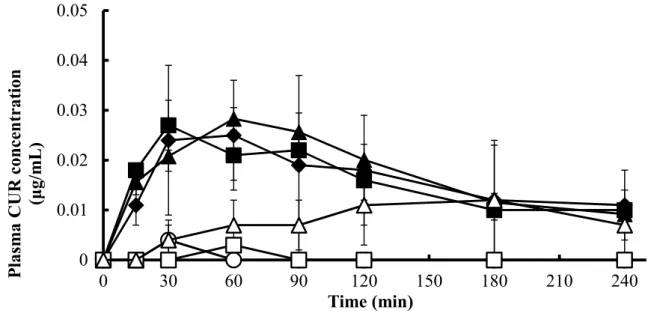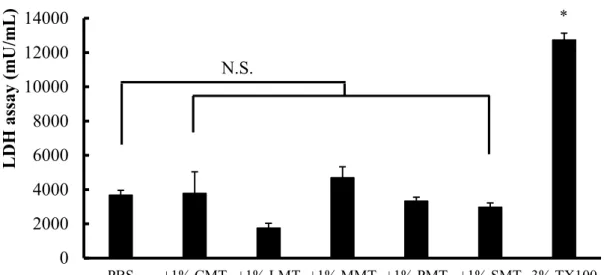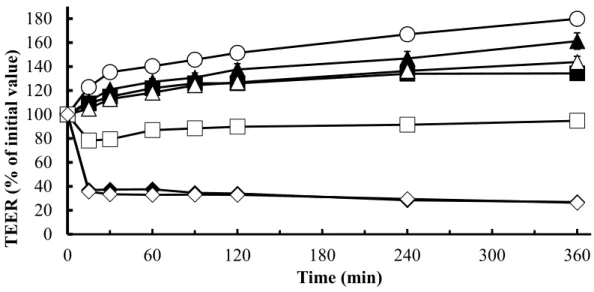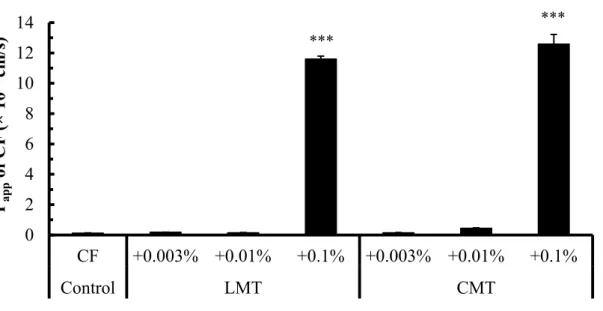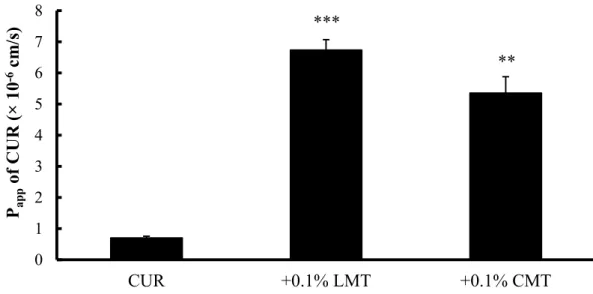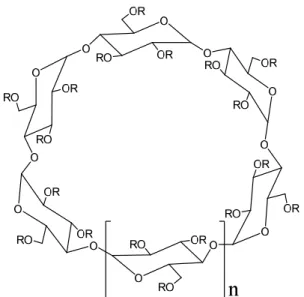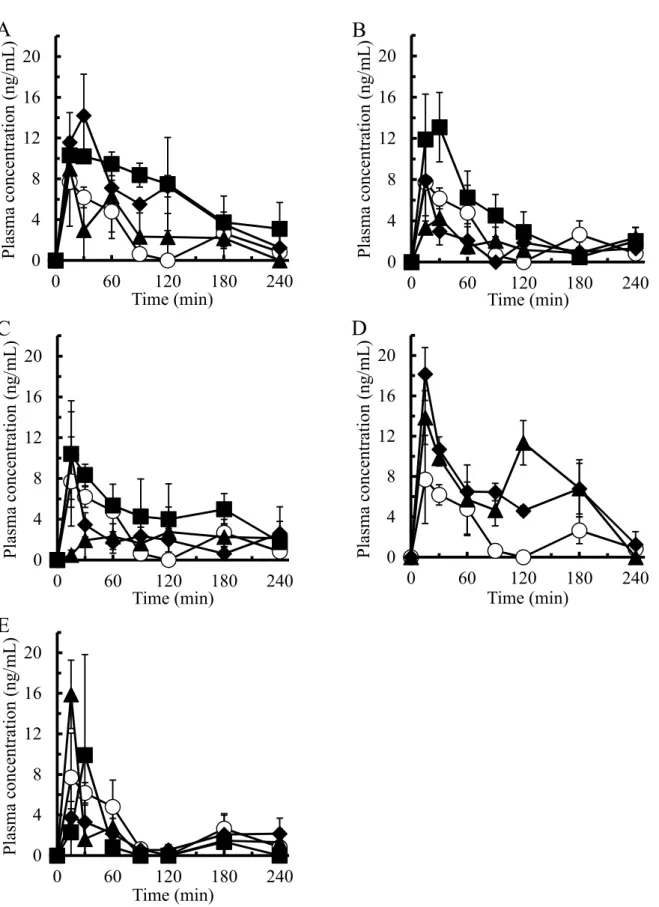Improvement of the solubility and intestinal absorption of curcumin by N-acyl taurates and cyclodextrins
Ph.D. Dissertation
Xinpeng Li
Department of Biopharmaceutics Kyoto Pharmaceutical University
Kyoto
2017
i
Table of Contents
Abstract ... vii
Introduction ... 1
Chapter I Improvement of the solubility and intestinal absorption of curcumin by N-acyl taurates ... 5
1.1 Materials and methods ... 6
1.1.1 Materials ... 6
1.1.2 Solubility of CUR in 1% NAT formulations ... 7
1.1.3 Intestinal absorption study of CUR with NATs ... 7
1.1.4 Intestinal membrane toxicity after administration of NATs ... 8
1.1.5 Cellular transport of CF and CUR with NATs ... 9
1.1.6 Determination of CUR by HPLC ... 11
1.1.7 Statistical Analyses ... 11
1.2 Results and discussion ... 12
1.2.1 Solubility of CUR improved by NATs ... 12
1.2.2 Intestinal absorption of CUR in the presence of NATs ... 13
1.2.3 Intestinal membrane toxicity in the presence of NATs ... 17
1.2.4 Effects of NATs on the permeation of poorly absorbable drugs across Caco-2 cell monolayers ... 18
1.3 Conclusions ... 22
Chapter II Improvement of the solubility and intestinal absorption of curcumin by cyclodextrins ... 23
2.1 Materials and methods ... 24
2.1.1 Materials ... 24
2.1.2 Preparation of CUR suspension in CD formulations ... 25
2.1.3 Intestinal absorption of drugs in the presence of CDs ... 26
ii
2.1.4 Toxicity study of CDs ... 26
2.1.5 Cellular transport of CF and CUR in the presence of α-CD ... 27
2.1.6 Western blotting analysis ... 28
2.1.7 Evaluation of intestinal membrane fluidity in the presence of α-CD ... 29
2.1.8 Statistical analyses ... 30
2.2 Results and discussion ... 31
2.2.1 Phase solubility study of CUR in CD formulations ... 31
2.2.2 Intestinal absorption of CUR in the presence of CDs ... 34
2.2.3 Intestinal absorption of hydrophilic molecules in 50 mM α-CD solution ... 38
2.2.4 Toxicity of CDs after intestinal administration ... 41
2.2.5 Effects of α-CD on the permeation of poorly absorbable compounds across Caco-2 cell monolayers. ... 44
2.2.6 Expression of claudin-4 in the presence of 50 mM α-CD ... 47
2.2.7 Effects of α-CD on the membrane fluidity ... 48
2.3 Conclusions ... 51
Summary ... 52
Acknowledgement ... 55
References ... 56
Publications and presentations ... 66
iii
Table of Tables
Table 1 Characteristics of CUR ... 4 Table 2 Solubility of CUR in the presence of 1% NATs ... 13 Table 3 Pharmacokinetic parameters of CUR in the presence of 1% NATs after intestinal administration to rats ... 15 Table 4 Estimation of bioavailability and absorption rate of CUR using a deconvolution method ... 16 Table 5 Solubility of CUR in the presence of CD solutions ... 32 Table 6 Pharmacokinetic parameters of CUR in the presence of CDs after intestinal
administration to rats ... 37
iv
Table of Figures
Fig. 1. Chemical structure of N-acyl taurates ... 6
Fig. 2. Absorption of CUR (200 mg/kg) from rat small intestines in the presence of 1% NATs ... 15
Fig. 3. The relationship between the solubility and intestinal absorption of CUR in the presence of 1% NATs ... 16
Fig. 4. The activity of LDH released from the intestinal membrane in the presence of 1% NATs ... 18
Fig. 5. TEER changes of Caco-2 cell monolayers in the presence of CMT and LMT ... 19
Fig. 6. Cellular transport of CF in the presence of either CMT or LMT ... 20
Fig. 7. Cellular transport of CUR in the presence of either CMT or LMT ... 22
Fig. 8. Chemical structure of cyclodextrins ... 24
Fig. 9. Phase-solubility diagrams of CUR-CD suspensions... 33
Fig. 10. Absorption of CUR (200 mg/kg) from rat small intestines in the presence of CD solutions ... 36
Fig. 11. The relationship between the solubility and intestinal absorption of CUR in the presence of CDs ... 38
Fig. 12. Effects of 50 mM α-CD on the intestinal absorption of hydrophilic molecules ... 40
Fig. 13. Measurements of LDH and proteins released from the intestinal membrane in the presence of CDs ... 42
Fig. 14. Histological micrographs of rat small intestinal tissue treated with 50 mM α-CD .... 43
Fig. 15. Hepatotoxicity and nephrotoxicity of 50 mM α-CD after intestinal administration ... 44
Fig. 16. Cellular transport of CF and CUR in the presence of α-CD ... 46
Fig. 17. Reduction and recovery of claudin-4 expression after the treatment with 50 mM α-CD ... 48
Fig. 18. Fluorescence anisotropy of DPH, tma-DPH, and DNS-Cl in the presence of α-CD .. 50
v
List of Abbreviations
ALT Alanine transaminase
AST Aspartate transaminase
AUC Area under the plasma drug concentration-time curve BBMV Brush border membrane vesicle
BSA Bovine serum albumin
BUN Blood urea nitrogen
Caco-2 Colon adenocarcinoma-2
CDs Cyclodextrins
CF 5(6)-Carboxyfluorescein
C
maxMaximum plasma drug concentration CMC Critical micelle concentration
CMT Sodium methyl cocoyl taurate
CUR Curcumin
DMEM Dulbecco’s Modified Eagle Medium
DNS-Cl Dansyl chloride
DPH 1,6-Diphenyl-1,3,5-hexatriene EDTA Ethylenediaminetetraacetic acid EGTA Ethylene glycol tetraacetic acid ErA Absorption enhancement ratio Ers Solubility enhancement ratio
FBS Fetal bovine serum
FD4 Fluorescein isothiocyanate-labeled dextrans with average molecular weights of 4000
FD10 Fluorescein isothiocyanate-labeled dextrans with average molecular weights of 10000
HBSS Hank’s balanced salt solution
HEPES 2-[4-(2-Hydroxyethyl)-1-piperazinyl]ethane sulfonic acid HPLC High-performance liquid chromatography
LDH Lactate dehydrogenase
LMT Sodium methyl lauroyl taurate
MC Methylcellulose
vi MMT Sodium methyl myristoyl taurate
NATs N-Acyl taurates
P
appApparent permeability coefficient PBS Phosphate buffered saline
P-gp P-glycoprotein
PMT Sodium methyl palmitoyl taurate PVDF Polyvinylidene difluoride
S.E. Standar error
SMT Sodium methyl stearoyl taurate TBST Tris-buffered saline and Tween 20 TEER Transepithelial electrical resistance
tma-DPH 1-(4-(Trimethylamino) phenyl)-6-phenylhexa-1,3,5-hexatriene-p- toluenesulfonate
T
maxTime to the maximum plasma drug concentration Tris Tris(hydroxymethyl)amino methane
TX100 Triton X-100
vii
Abstract
Curcumin is a polyphenolic compound named as (1E,6E)-1,7-bis(4-hydroxy-3-
methoxyphenyl)hepta-1,6-diene-3,5-dione; CAS number: 458-37-7. The molecular formula is
C
21H
20O
6and it has a molecular weight of 368 g/mol. This compound is derived from Curcuma
longa L. and has demonstrated versatile pharmacological effects including anti-inflammatory
and antioxidant actions in extensive preclinical studies. In addition, the therapeutic effects, such
as anti-tumors, were studied in human clinical trials over the last few decades. In terms of the
high dose at 12 g per day in healthy volunteers, curcumin was well tolerated in the oral
administration and appeared to be safe for the clinical use. However, based on the poor aqueous
solubility and low intestinal permeability of curcumin, the natural product is classified as a
biological classification system (BCS) Class IV molecule. The hydrolytic and light-sensitive
properties also cause the rapid degradation of this natural polyphenol. Due to these
characteristics, curcumin showed a low concentration in plasma after oral administration
resulting in a poor bioavailability. Various approaches have been developed to overcome the
bioavailability problem, such as nanoformulations. Because many ingredients in formulae are
used for both solubilizers and permeation enhancers, it is of interest to investigate their multiple
functions with respect to drug absorption. In our recent research, amorphous solid particles of
curcumin showed an enhanced permeation across the absorptive membrane, while it was not
observed in the presence of crystalline particles or supersaturated solution. Consequently, since
the crystalline powder is more stable than the amorphous particles in dosage forms, the present
study was focused on the development of new curcumin formulations using crystalline particles
with absorption enhancers and examined their absorption-enhancing mechanisms.
viii
Chapter I Improvement of the solubility and intestinal absorption of curcumin by N-acyl taurates (NATs)
NATs are a subset of acylated amino acids which are surfactants with natural lipid-like structures that exhibit amphiphilic properties. In this chapter, the effects of NATs on the small intestinal absorption of curcumin were examined in rats by an in situ closed-loop method.
Among these NATs, 1% (v/v) sodium methyl lauroyl taurate (LMT) and sodium methyl cocoyl taurate (CMT) were the most effective in increasing the solubility and intestinal absorption of curcumin. The intestinal membrane toxicity of NATs was also evaluated by measuring the activity of lactate dehydrogenase (LDH), a cytotoxicity marker. All of them did not increase the activity of LDH in the luminal fluid, suggesting that they may be safely administered orally.
The relationship between the solubility and absorption demonstrated that the drug solubility is an important factor contributing to the absorption of curcumin. However, the drug absorption was not changed when the solubility was higher than 5 μg/mL, which means that the rate- limiting step was shifted from the apparent solubility of curcumin to the permeation across the intestinal membrane. Thus, the absorption-enhancing mechanism was elucidated in the paracellular pathway using Caco-2 cells. In cellular transport studies, LMT and CMT reduced the transepithelial electrical resistance (TEER) values of Caco-2 cells and increased the transport of 5(6)-carboxyfluorescein (CF) and curcumin. Hence, besides the increased solubility, the improved permeability of curcumin by LMT and CMT also contributed to the intestinal absorption.
Chapter II Improvement of the solubility and intestinal absorption of curcumin by cyclodextrins (CDs)
CDs are a unique type of macrocyclic carriers widely used in pharmaceutical formulations
owing to their versatile functions as the solubilization, stabilization, and permeation
ix
enhancement. In this chapter, α-CD, β-CD, γ-CD, hydroxypropyl (HP)-β-CD, and dimethyl (DM)-β-CD were applied to the formulation of curcumin. The interaction between curcumin and CD molecules was investigated by phase-solubility diagrams, suggesting that 1:1 complex formation was observed in the solution except for γ-CD. The effects of various CDs on the intestinal absorption of curcumin were evaluated in rat intestine by the in situ closed-loop experiment. Among the tested CDs, 50 mM α-CD significantly enhanced the intestinal absorption of curcumin without causing any serious toxicity to tissues like intestinal membrane, liver, and kidney. In addition to curcumin, 50 mM α-CD increased the intestinal absorption of hydrophilic drugs including CF, fluorescein isothiocyanate-labeled dextrans with average molecular weights of 4000 (FD4), FD10, and salmon calcitonin, suggesting a molecular weight dependency of the absorption-enhancing ability. The analysis of cellular transport across Caco- 2 cell monolayers showed that 50 mM α-CD reduced the TEER value of cell monolayers and improved the paracellular permeability of CF. Furthermore, in the western blotting analysis, α- CD decreased the expression of claudin-4, a tight junction-associated protein, in brush border membrane. Additionally, α-CD increased the membrane fluidity of lipid bilayers in brush border membrane vesicles and may also promote the permeation of drug molecules via the transcellular pathway. Upon these results, it is concluded that 50 mM α-CD is the optimal CD formulation to enhance the absorption not only by solubilizing curcumin but also by assisting its permeation across the intestinal membrane.
Summary
When the solubility was higher than 5 μg/mL, the rate-limiting step of curcumin absorption
was shifted from the apparent drug solubility to the permeation across the intestinal membrane,
which confirmed the drawbacks of curcumin in both solubility and permeability. Of tested
absorption enhancers, 1% (v/v) LMT or CMT, and 50 mM α-CD significantly improved the
x
absorption of curcumin from the rat small intestine without inducing any serious toxicity to
intestinal tissue or organs. The absorption-enhancing effect of these materials on the
paracellular pathway was evidenced by Caco-2 cell model. In particular, α-CD altered the
barrier properties of both the paracellular and transcellular pathways. Therefore, the intestinal
absorption enhancement by absorption enhancers might be attributed to the synergistic effect
of increased solubility and permeability of curcumin in their presence.
1 Introduction
Curcuma longa L. is a medicinal plant of the ginger family which has been used for many centuries in India, China, and South East Asia. As claimed in the traditional medicine, it has therapeutic effects to various diseases, such as biliary disorders, anorexia, coryza, cough, diabetic wounds, hepatic disorder, rheumatism, sinusitis, abdominal pains, sprains, and swellings caused by injury.
1)As the major component, curcumin (CUR) has demonstrated versatile pharmacological effects in extensive animal models where it worked as anti- inflammatory, antioxidant, anticarcinogen, antimicrobial, hepatoprotective, thrombosuppressive, cardiovascular, hypoglycemic, and antiarthritic agents. It also exhibited biological activities to Alzheimer’s diseases, cataract formation, pulmonary toxicity and fibrosis, psoriasis, and renal ischemia.
2,3)The underlying mechanisms of the treatment may be due to the modulation of immune responses by CUR through its direct actions on signal pathways or target gene expression.
4,5)Furthermore, the therapeutic activities of CUR have been evaluated in human clinical trials which revealed the potential actions to tumors and psoriasis vulgaris.
6,7)In terms of the high dose at 12 g per day used in healthy volunteers, CUR was well tolerated in the oral administration and appeared to be safe for the clinical use.
8)CUR is a polyphenolic compound characterized in Table 1. Due to these characteristics, CUR appears to be a low concentration in plasma after oral administration, resulting in a poor bioavailability.
9)To achieve much more therapeutic effects, various approaches have been developed by many scientists in the world, such as co-administration of CUR with inhibitors of glucuronidation or prodrugs by conjugation.
10-12)In current days, CUR nanoformulations have attracted great attention including liposomes, solid lipid nanoparticles, niosomes, polymeric nanoparticles, polymeric micelles, cyclodextrins, dendrimers, silver and gold nanoparticles.
Most of these nanoformulations were attempted to solubilize CUR and increase its stability in
2
aqueous solutions. Nevertheless, because many ingredients in formulae are used for both solubilizers and permeation enhancers, it is of interest to investigate their multiple functions with respect to drug absorption.
Recently, we developed a novel strategy for improving the bioavailability of CUR by amorphous solid particles.
13)It is found that these drug particles enhanced the permeation across the absorptive membrane which was not observed in the presence of crystalline CUR powder or supersaturated solution. Consequently, since the crystalline powder is more stable than the amorphous particles in dosage forms, the present study was focused on the development of new curcumin formulations using crystalline particles with absorption enhancers and examined their absorption-enhancing mechanisms.
Up to date, more than 200 intestinal absorption enhancers have been published in previous
preclinical studies, some of which also have been undergoing the investigation in the clinical
trials.
14,15)Over the past few decades, our research has been demonstrating several promising
absorption enhancers including surfactants, protease inhibitors, NO donors, and polymers,
which showed a strong absorption-enhancing efficacy and a low local toxicity in animal or cell
studies. Of various surfactants, bile salts, sodium glycocholate and sodium taurocholate, and
alkylsaccharide, N-lauryl-β-D-maltopyranoside increased the intestinal absorption of poorly
absorbed drugs including 5(6)-carboxyfluorescein (CF), phenol red, human calcitonin, ebiratide,
enkephalin analogs, and insulin.
16-23)As a new type absorption enhancer, Gemini surfactant,
sodium dilauramidoglutamide lysine also exhibited the intestinal absorption-enhancing effects
on small hydrophilic molecules and macromolecules like protein and peptide drugs.
24)In
addition, other types of surfactants, including sucrose fatty acids esters, N-acyl amino acids,
and N-acyl taurates improved the poor absorption of alendronate from the intestine.
25,26)With
respect to protease inhibitors, bacitracin promoted the intestinal absorption of peptide and
protein drugs by improving drug stability against the peptidases in the intestinal regions.
27-29)3
In comparison to the conventional absorption enhancers, NO donors were able to enhance the absorption of CF without any regional difference in the intestine.
30)In terms of polymers, polyamidoamine (PAMAM) dendrimers improved the absorption of peptide and protein drugs either in nasal delivery or in pulmonary administration.
31,32)On the other hand, the polymers, such as polyethylene glycol 20000 and polyoxyethylene alkyl ethers worked as P-gp modulators to reverse the efflux activity produced by P-gp transporters.
33,34)As reported in these studies, most of these absorption enhancers were safe to the mucosal membrane without causing serious damages. Thus, applying absorption enhancers in formulations is still a useful strategy to enhance the intestinal absorption of poorly absorbable drugs like CUR.
In this study, the intestinal absorption of CUR was examined using an in situ closed-loop experiment in the presence of various absorption enhancers. To investigate the mechanisms of absorption enhancement of CUR, the factors as solubilization and permeation enhancement were evaluated when the natural product was co-administered with the absorption enhancers.
Regarding the drug permeation, the cellular transport of CF, a paracellular marker, was examined in Caco-2 cell monolayers and the intestinal expression of claudin-4 was determined in brush border membrane vesicles (BBMVs) in the combination with a absorption enhancer.
Furthermore, the transcellular permeation of CUR enhanced by the absorption enhancer was
also evaluated in light of the membrane fluidity of BBMVs.
4 Table 1 Characteristics of CUR
35)Chemical name (1E,6E)-1,7-bis(4-hydroxy-3-methoxyphenyl)hepta- 1,6-diene-3,5-dione
C.A.S number 458-37-7
Molecular formula C
21H
20O
6Molecular weight 368 g/mol
Chemical structure
Enol form (at pH > 8)
Keto form (at pH 1-7) Physical and chemical properties
Physical state Solid crystalline
Color Orange-yellow (at pH = 7)
Odor odorless
Solubility 11 ng/mL (in water at pH 5)
36)Permeability Log Kow = 3.29
apK
a7.8, 8.5 and 9.0
37)Light sensitivity Light sensitive
a

